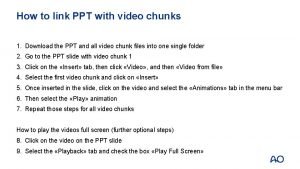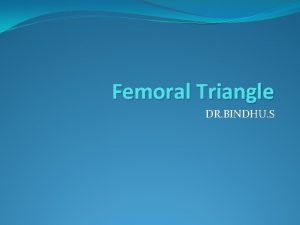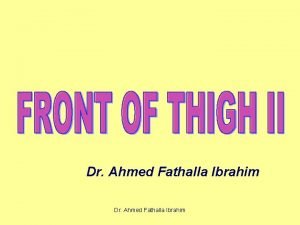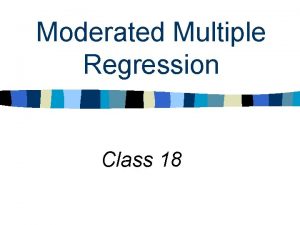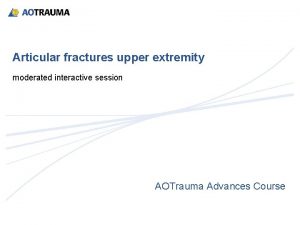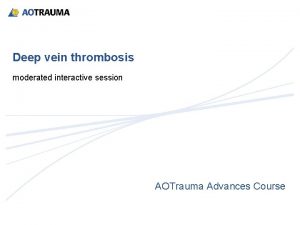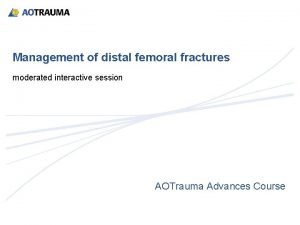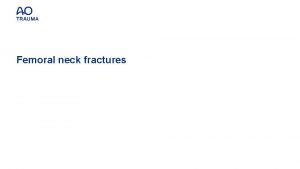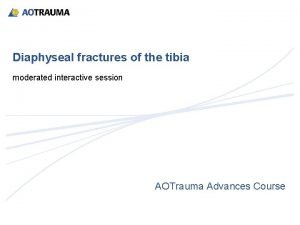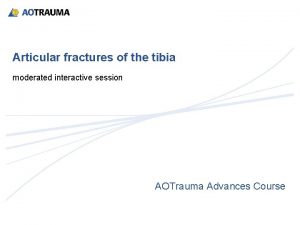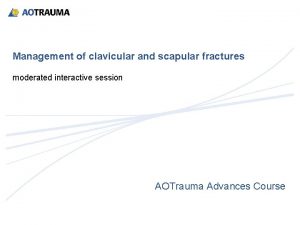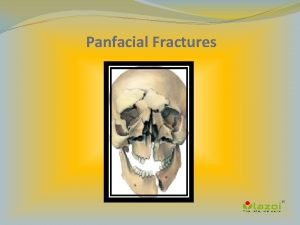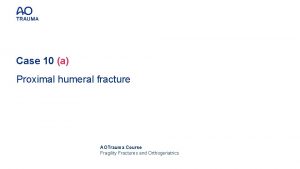Proximal femoral fractures moderated interactive session AOTrauma Advances














- Slides: 14

Proximal femoral fractures moderated interactive session AOTrauma Advances Course

Learning outcomes • Formulate a treatment plan for femoral neck fractures in the young patient • Identify treatment options for femoral neck fractures in the young patient and elderly patient • Assess complexity of the trochanteric fracture • Appraise the factors influencing the outcome

Is nailing your first choice when treating stable trochanteric fractures? 1. Never 2. Rarely 3. Occasionally 4. Commonly

Is nailing your first choice when treating unstable trochanteric fractures? 1. Never 2. Rarely 3. Occasionally 4. Commonly

How do you treat a 65 -year-old male with a displaced femoral neck fracture? 1. Open reduction internal fixation 2. Closed reduction internal fixation 3. Total hip replacement 4. Bipolar arthroplasty

Key points from lectures High-velocity femoral neck fractures in young patients • Long-term results are influenced by fracture displacement and quality of reduction • Early capsulotomy and osteosynthesis may have some benefits • Open reduction through anterior approach recommended if closed reduction fails • Vertical shearing is common and needs angular-stable internal fixation

Key points from lectures Femoral neck fractures in elderly patients—repair vs replacement ORIF • Healthy young patients • Best results with anatomical reduction Replacement • Better functional outcomes in older patients • Use cement in healthy patients • Consider THA in healthy patients • Bipolars little evidence base for use and costly • Austin-Moore prosthesis for minimal/nonambulators

Key points from lectures Treatment options/outcomes for trochanteric fractures • 31 -A. 1 “stable” fractures can be treated with any (sliding) extra/intramedullary device with excellent outcome • 31 -A. 2 “unstable” fractures should be treated with an intramedullary implant • No evidence that intramedullary devices perform better

How would you treat this 23 -year-old with a displaced femoral neck fracture? 1. Immediate surgery in less than 2 hours 2. Emergent surgery in less than 6 hours 3. Urgent surgery in less than 24 hours 4. No urgency, but when time is available

In this 23 -year-old is an open reduction always indicated? 1. Yes—always 2. No—never 3. Sometimes, if the fracture is not reducible with closed reduction 4. Rarely but only in high-energy femoral neck fractures

In this 23 -year-old is an arthrotomy always indicated for relieving intracapsular pressure? 1. Yes—always 2. No—never 3. Sometimes, if the fracture is not reducible with closed reduction 4. Rarely, but only in high-energy femoral neck fractures

How would you treat this healthy 67 -year-old female with a displaced femoral neck fracture? 1. Bipolar hemiarthroplasty 2. Unipolar hemiarthroplasty 3. Total hip arthroplasty 4. Cannulated screws 5. Sliding hip screw

How would you treat this healthy 67 -year-old female with a displaced 4 -part trochanteric fracture? 1. Sliding hip screw 2. Intramedullary nail 3. Either 4. Other

Summary—proximal femoral fractures • Femoral neck fractures in young patients deserve emergent treatment • Accurate reduction and stable fixation is key to good results • Timing has yet to be clarified but “sooner rather than later” • Capsulotomy although commonly recommended has little evidence base • THA provides better function outcomes for fit elderly patients • For stable intertrochanteric fractures, sliding hip screw is the implant of choice • With increasing instability, cephalomedullary devices may be more effective
 Aotrauma reference
Aotrauma reference Proximal femoral nail ppt
Proximal femoral nail ppt Femoral canal structures
Femoral canal structures Termination of femoral artery
Termination of femoral artery Simple mediation model
Simple mediation model Mediator vs moderator
Mediator vs moderator Moderated multiple regression
Moderated multiple regression Moderated multiple regression
Moderated multiple regression Poster imrad
Poster imrad Coherent scattering
Coherent scattering Recent advances in dental ceramics
Recent advances in dental ceramics Advances in technology during wwii
Advances in technology during wwii Asset classification norms
Asset classification norms Lesson 9.1 intellectual advances in the first year
Lesson 9.1 intellectual advances in the first year What is long term loans and advances
What is long term loans and advances

